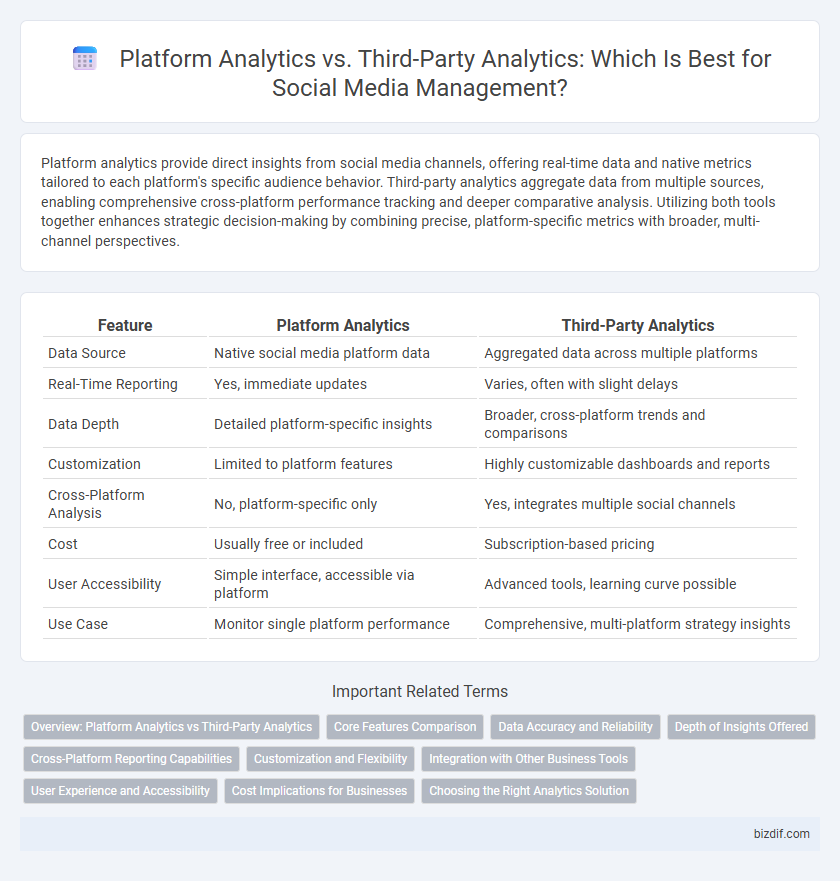Platform analytics provide direct insights from social media channels, offering real-time data and native metrics tailored to each platform's specific audience behavior. Third-party analytics aggregate data from multiple sources, enabling comprehensive cross-platform performance tracking and deeper comparative analysis. Utilizing both tools together enhances strategic decision-making by combining precise, platform-specific metrics with broader, multi-channel perspectives.
Table of Comparison
| Feature | Platform Analytics | Third-Party Analytics |
|---|---|---|
| Data Source | Native social media platform data | Aggregated data across multiple platforms |
| Real-Time Reporting | Yes, immediate updates | Varies, often with slight delays |
| Data Depth | Detailed platform-specific insights | Broader, cross-platform trends and comparisons |
| Customization | Limited to platform features | Highly customizable dashboards and reports |
| Cross-Platform Analysis | No, platform-specific only | Yes, integrates multiple social channels |
| Cost | Usually free or included | Subscription-based pricing |
| User Accessibility | Simple interface, accessible via platform | Advanced tools, learning curve possible |
| Use Case | Monitor single platform performance | Comprehensive, multi-platform strategy insights |
Overview: Platform Analytics vs Third-Party Analytics
Platform analytics provide direct insights from social media channels like Facebook Insights or Twitter Analytics, offering real-time data on user engagement, reach, and demographics. Third-party analytics tools aggregate data across multiple platforms, delivering comprehensive reports and deeper trend analysis that enhance strategic decision-making. Businesses benefit from using platform analytics for immediate performance tracking while leveraging third-party solutions for cross-channel comparisons and advanced metrics.
Core Features Comparison
Platform analytics offer native insights directly from social media sites, providing real-time engagement metrics, audience demographics, and content performance specific to each platform. Third-party analytics aggregate data across multiple social networks, enabling cross-platform reporting, advanced sentiment analysis, and customizable dashboards. Key differences include data depth, integration capabilities, and the ability to track competitor performance comprehensively.
Data Accuracy and Reliability
Platform analytics offer data accuracy and real-time insights directly from social media networks, ensuring reliability through native tracking methods. Third-party analytics aggregate data across multiple platforms, but discrepancies can arise due to API limitations and data processing delays. Choosing platform analytics enhances precision in engagement metrics, while third-party tools provide broader cross-channel analysis despite occasional accuracy trade-offs.
Depth of Insights Offered
Platform analytics provide direct access to native data, delivering detailed real-time metrics on user engagement, reach, and content performance specific to each social media network. Third-party analytics aggregate data from multiple platforms, enabling comprehensive cross-channel comparisons and trend analysis that platform tools may lack. While platform analytics excel in granular, platform-specific insights, third-party solutions offer broader strategic overviews with advanced reporting and customizable dashboards.
Cross-Platform Reporting Capabilities
Platform analytics offer detailed insights tailored to specific social networks but often lack comprehensive cross-platform integration. Third-party analytics tools provide unified dashboards that aggregate data from multiple social media channels, enabling holistic performance tracking and comparison. Enhanced cross-platform reporting capabilities improve decision-making by revealing overall trends and audience behaviors across various social media environments.
Customization and Flexibility
Platform analytics provide real-time data tightly integrated with native features, ensuring high accuracy but limited customization options. Third-party analytics offer extensive flexibility with customizable dashboards and cross-platform data aggregation, enabling tailored insights beyond basic metrics. Choosing between these depends on the need for specific, customizable reporting or seamless platform-specific data integration.
Integration with Other Business Tools
Platform analytics provide seamless integration with native business tools such as CRM systems and marketing automation software, enhancing workflow efficiency and data accuracy. Third-party analytics offer broader compatibility across multiple platforms but may require additional configuration to synchronize with existing business applications. Choosing between them depends on the balance between integration depth and cross-platform flexibility needed for effective social media management.
User Experience and Accessibility
Platform analytics offer real-time insights directly within the native social media environment, ensuring seamless user experience and easy access to data tailored for the platform's specific features. Third-party analytics provide a broader overview across multiple channels, often with customizable dashboards that enhance accessibility for comprehensive reporting. Users benefit from platform analytics' immediacy and authenticity, while third-party tools excel in cross-platform integration and in-depth data visualization.
Cost Implications for Businesses
Platform analytics offer basic insights directly from social media channels at no extra cost, reducing expenses for businesses seeking essential performance data. Third-party analytics tools often charge subscription fees but provide advanced metrics, cross-platform integration, and customizable reports, enabling more comprehensive social media strategies. Businesses must assess their budget and analytical needs to determine whether free platform analytics or paid third-party solutions deliver the best return on investment.
Choosing the Right Analytics Solution
Platform analytics offer direct integration and real-time data accuracy, essential for monitoring native engagement metrics and user behavior on social channels like Facebook Insights or Twitter Analytics. Third-party analytics provide comprehensive cross-platform insights and customizable reporting, enabling deeper trend analysis and ROI measurement across multiple social networks. Selecting the right analytics solution depends on prioritizing either immediate platform-specific data or a holistic view for strategic decision-making.
Platform analytics vs Third-party analytics Infographic

 bizdif.com
bizdif.com